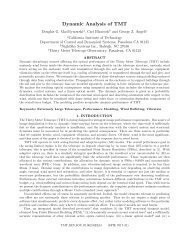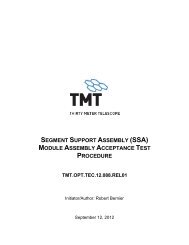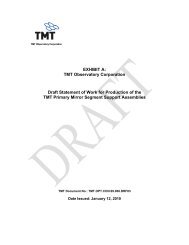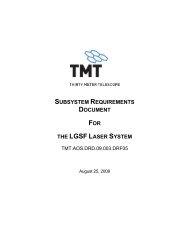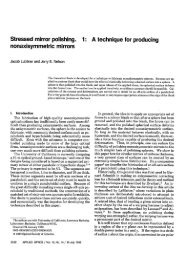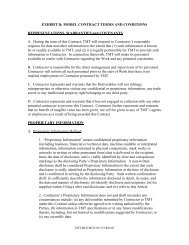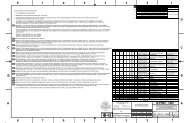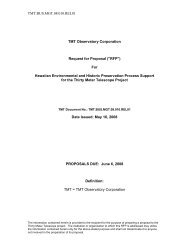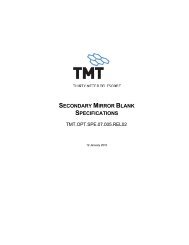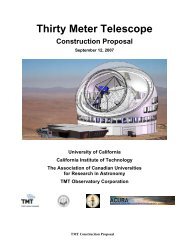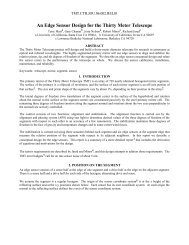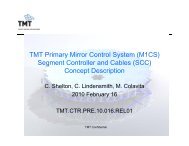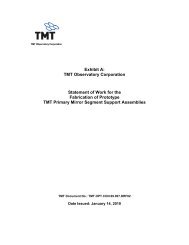Advancement of the Segment Support System - Thirty Meter Telescope
Advancement of the Segment Support System - Thirty Meter Telescope
Advancement of the Segment Support System - Thirty Meter Telescope
Create successful ePaper yourself
Turn your PDF publications into a flip-book with our unique Google optimized e-Paper software.
The surface deformation pr<strong>of</strong>ile plot, Figure 15, compares <strong>the</strong> character <strong>of</strong> <strong>the</strong> surface deformations from <strong>the</strong> three<br />
diaphragm designs. The amplitude and spatial frequency <strong>of</strong> <strong>the</strong> deformation differs for Option-2 (convolution and slots)<br />
compared to <strong>the</strong> two flat diaphragms (Options-1 and -3). The flat diaphragms introduce two local bending moments into<br />
<strong>the</strong> mirror as load is transferred at <strong>the</strong> 12- and 6-o’clock locations (as discussed in Section 4.2.2). These two moments<br />
are separated along <strong>the</strong> line <strong>of</strong> action, thus giving rise to <strong>the</strong> pair <strong>of</strong> asymmetric bumps. Conversely, Option-2<br />
(convolution and slots) transfers loads into <strong>the</strong> mirror at <strong>the</strong> 3- and 9-o’clock locations (as described in Section 4.2.2),<br />
resulting in a single combined moment with twice <strong>the</strong> magnitude, centered along <strong>the</strong> line <strong>of</strong> action.<br />
Surface distortion, nm<br />
150<br />
100<br />
50<br />
0<br />
-50<br />
-100<br />
Option-2, With convolution and slots<br />
Option-3, Flat with slotted rim<br />
Option-1, Flat without slots<br />
-150<br />
-0.75 -0.5 -0.25 0 0.25 0.5 0.75<br />
X-coordinate, m<br />
Figure 15 Surface pr<strong>of</strong>ile plot <strong>of</strong> lateral gravity distortion for <strong>the</strong> three diaphragm design options. Pr<strong>of</strong>ile<br />
trajectory is across segment vertices at Y = 0, for <strong>the</strong> 1g X load case.<br />
4.4 Preferred diaphragm design<br />
Optical performance results are summarized in Table 2 for <strong>the</strong> three diaphragm designs. Each design has similar Axial<br />
gravity performance, which is expected since all three configurations utilize <strong>the</strong> same axial support systems. Thus, axial<br />
gravity performance is not a differentiating factor in evaluating <strong>the</strong> design options.<br />
Comparing <strong>the</strong> Thermal distortion and Lateral gravity results, Option-2 is extremely good for <strong>the</strong>rmal distortion, but<br />
with significantly higher surface figure error when subject to lateral gravity. Since lateral gravity distortion is <strong>of</strong> high<br />
spatial frequency, <strong>the</strong> optical consequences in <strong>the</strong> telescope are more significant than <strong>the</strong> <strong>the</strong>rmal distortion errors which<br />
contain a significant amount <strong>of</strong> low-order error, as discussed in Section 3. Based on this, <strong>the</strong> lowest lateral gravity<br />
distortion is selected and a slightly larger <strong>the</strong>rmal distortion effect is accepted. Option-3 (flat diaphragm with a slotted<br />
outer rim) is found to be <strong>the</strong> best compromise. This design has good lateral gravity performance, and improved <strong>the</strong>rmal<br />
performance, compared to <strong>the</strong> un-slotted flat diaphragm, Option-1, <strong>the</strong>refore <strong>the</strong> flat diaphragm with <strong>the</strong> slotted outer rim<br />
(Option-3) was chosen as <strong>the</strong> baseline for <strong>the</strong> TMT <strong>Segment</strong> <strong>Support</strong> Assembly.<br />
Diaphragm Type<br />
Thermal distortion<br />
surface error<br />
(nm/°C)<br />
Axial gravity Lateral gravity surface error (nm)<br />
surface error<br />
(1g Z ) (nm) (1g X ) (1g Y )<br />
RMS PV RMS PV RMS PV RMS PV<br />
Option-1,<br />
Flat with un-slotted rim<br />
Option-2,<br />
Convolution & slotted rim<br />
Option-3,<br />
Flat with slotted rim<br />
3.19 22.1 10.37 60.4 11.91 217. 11.77 218.<br />
1.57 7.71 10.69 59.7 16.56 272. 16.66 273.<br />
2.28 13.11 10.37 60.3 11.99 219. 11.83 219.<br />
Table 2<br />
Summary <strong>of</strong> predicted surface errors for three candidate TMT central diaphragm designs.



